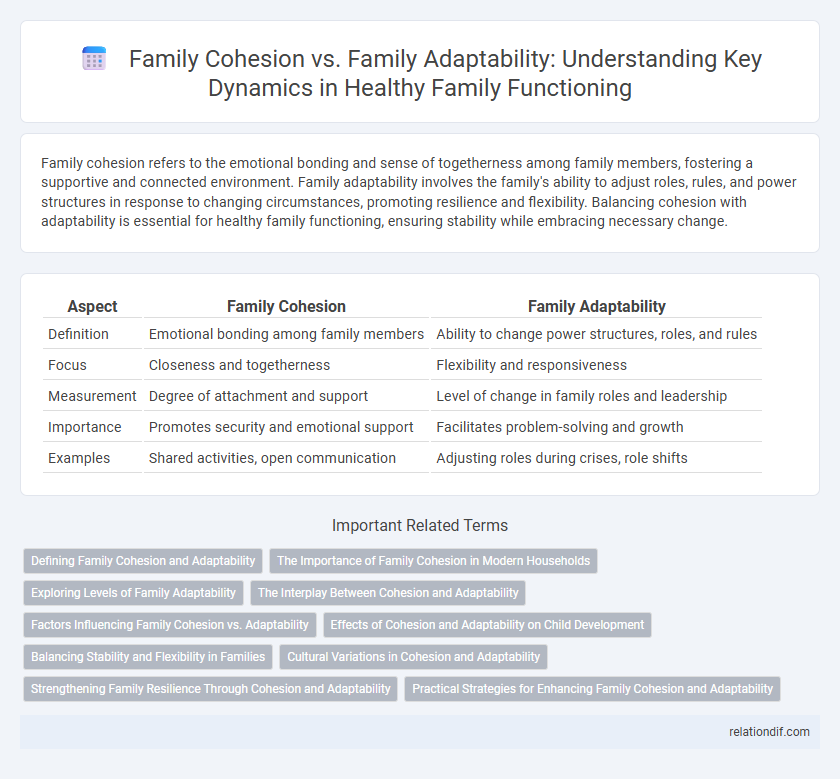Family cohesion refers to the emotional bonding and sense of togetherness among family members, fostering a supportive and connected environment. Family adaptability involves the family's ability to adjust roles, rules, and power structures in response to changing circumstances, promoting resilience and flexibility. Balancing cohesion with adaptability is essential for healthy family functioning, ensuring stability while embracing necessary change.
Table of Comparison
| Aspect | Family Cohesion | Family Adaptability |
|---|---|---|
| Definition | Emotional bonding among family members | Ability to change power structures, roles, and rules |
| Focus | Closeness and togetherness | Flexibility and responsiveness |
| Measurement | Degree of attachment and support | Level of change in family roles and leadership |
| Importance | Promotes security and emotional support | Facilitates problem-solving and growth |
| Examples | Shared activities, open communication | Adjusting roles during crises, role shifts |
Defining Family Cohesion and Adaptability
Family cohesion refers to the emotional bonding and sense of togetherness among family members, reflecting the strength of their relationships and mutual support. Family adaptability describes the family's capacity to change its power structure, roles, and rules in response to situational and developmental stress. High cohesion and adaptability promote healthy family functioning, enabling families to effectively cope with challenges and maintain stability.
The Importance of Family Cohesion in Modern Households
Family cohesion fosters emotional bonding, trust, and mutual support, which are essential for resilience in modern households facing rapid societal changes. High levels of family cohesion contribute to improved communication, conflict resolution, and overall psychological well-being among family members. Research shows that cohesive families exhibit greater adaptability, enabling them to navigate stressors and maintain stability in dynamic environments.
Exploring Levels of Family Adaptability
Family adaptability refers to the ability of a family system to change its power structure, roles, and rules in response to situational and developmental stress. High levels of family adaptability are linked to better coping mechanisms during crises, promoting resilience and long-term stability within the family unit. Research indicates that families with balanced adaptability tend to experience greater emotional support, improved communication, and stronger relational bonds.
The Interplay Between Cohesion and Adaptability
Family cohesion represents the emotional bonding among family members, while family adaptability refers to the family's ability to change its power structure, roles, and rules in response to stress or developmental shifts. The interplay between cohesion and adaptability determines family functioning, with balanced levels fostering resilience and positive outcomes. Excessive cohesion can lead to enmeshment, whereas too much adaptability may cause chaos, highlighting the importance of achieving optimal synergy between these dimensions.
Factors Influencing Family Cohesion vs. Adaptability
Family cohesion is strongly influenced by emotional bonding, communication patterns, and shared values, which foster unity and mutual support. Family adaptability depends on the ability to modify roles, rules, and power structures in response to stress or change, highlighting flexibility in problem-solving and decision-making. External factors such as cultural background, socioeconomic status, and life transitions further shape the balance between cohesion and adaptability in family dynamics.
Effects of Cohesion and Adaptability on Child Development
Family cohesion, characterized by emotional bonding and consistent support, significantly enhances a child's social competence and emotional stability. High family adaptability, which reflects the family's ability to adjust roles and rules in response to stress, fosters resilience and problem-solving skills in children. Optimal child development occurs when families balance cohesion and adaptability, creating a nurturing yet flexible environment that promotes psychological well-being and effective coping mechanisms.
Balancing Stability and Flexibility in Families
Family cohesion fosters emotional bonding and a sense of belonging, while family adaptability ensures that members can adjust to changing circumstances and stressors. Balancing stability in routines and traditions with flexibility in roles and decision-making promotes resilience and healthy family functioning. This equilibrium allows families to support individual growth while maintaining a strong, united foundation.
Cultural Variations in Cohesion and Adaptability
Family cohesion and adaptability vary significantly across cultures, reflecting diverse social norms and values that shape family functioning. Collectivist societies often emphasize high cohesion with interdependent relationships, while individualistic cultures may encourage adaptability to support personal autonomy. Research highlights that cultural context influences how families balance emotional bonding and flexibility in roles, influencing overall family resilience and well-being.
Strengthening Family Resilience Through Cohesion and Adaptability
Strengthening family resilience depends on balancing family cohesion, which fosters emotional bonding and support, with family adaptability that enables flexible roles and problem-solving during change. High cohesion promotes trust and communication, essential for facing stressors, while adaptability ensures the family can reorganize and adjust to new circumstances effectively. Research shows that families exhibiting both strong cohesion and adaptability demonstrate greater resilience, leading to improved mental health and relational stability.
Practical Strategies for Enhancing Family Cohesion and Adaptability
Practical strategies for enhancing family cohesion and adaptability include establishing open communication channels, promoting shared family routines, and encouraging emotional support during stressful times. Implementing flexible problem-solving approaches and fostering individual family members' resilience can strengthen family adaptability. Regular family meetings and collaborative decision-making processes contribute to maintaining harmony and adjusting effectively to changing circumstances.
family cohesion vs family adaptability Infographic

 relationdif.com
relationdif.com